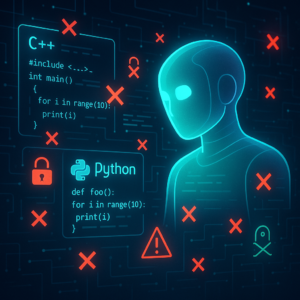Using Large Language Model to Support Flexible and Structural Inductive Qualitative Analysis

Revolutionizing Qualitative Analysis: Introducing MindCoder
In the whirlwind of today’s fast-paced world, the need for swift yet insightful data analysis has never been clearer. While traditional qualitative analysis is renowned for its thoroughness, it often grapples with time constraints and the necessity for extensive collaboration. Cue MindCoder—a groundbreaking tool aiming to harness the power of technology and redefine how we approach qualitative data analysis. But what exactly is MindCoder, and how can it transform the analytical landscape? Sit back and dive into this comprehensive exploration.
The Old School: Traditional Qualitative Analysis
Before we leap into MindCoder, it’s crucial to understand the roots of qualitative analysis. Historically, this methodology has been the backbone for extracting meaningful patterns, themes, and theories from qualitative data sources like interviews, transcriptions, or open-ended surveys. Typically, it involves:
- Open Coding: This initial step categorizes data into distinct themes or concepts.
- Discussions and Collaborations: Analysts engage in dialogues to reach consensus on the codes.
- Codebook Merging: Finalizing the process by consolidating codes for broader consistency.
While these steps ensure thoroughness and accuracy, they also demand considerable time and collaboration, making them cumbersome for tasks demanding quick insights.
Meet MindCoder: A Modern-Day Solution
To address the need for expeditious yet structured insights, researchers Jie Gao, Zhiyao Shu, and Shun Yi Yeo ventured beyond conventional boundaries, creating MindCoder. Designed with inspiration from the “Codes-to-theory” model, MindCoder arrives with an ambition: to streamline the qualitative analysis process without sacrificing structural integrity.
How MindCoder Works
To understand how MindCoder can serve you, let’s break down its core functionalities:
1. Data Preprocessing
MindCoder employs OpenAI’s GPT-4o model to efficiently preprocess data, a step crucial for preparing raw data for meaningful analysis. This involves organizing and cleaning datasets to ensure they’re ready for subsequent coding steps. It’s like setting up a canvas before painting – preparation ensures clarity.
2. Automatic Open Coding
Leveraging advanced AI algorithms, MindCoder automates the open coding process. By scanning through vast chunks of data, it identifies themes and patterns with impressive speed. For any individual who’s slogged through pages of transcriptions to find recurring themes, this feature is a game-changer.
3. Automatic Axial Coding
Building upon identified themes, MindCoder performs axial coding. This phase dives deeper into understanding relationships between codes. By establishing connections, it provides richer insights—like seeing the intricate tapestry of a story rather than disjointed tales.
4. Concept Development
The journey doesn’t stop at connecting dots. MindCoder advances into concept development, synthesizing these connections into coherent theories. Here, data transforms into narratives, offering deeper understanding and insights.
5. Insight Presentation
Finally, MindCoder packages its analysis into a comprehensive report, ensuring insights are both accessible and actionable. It’s not just about deciphering data; it’s about storytelling in a manner that drives action and understanding.
Evaluating MindCoder’s Effectiveness
In evaluating MindCoder, the creators rolled up their sleeves and put it to test with 12 participants from varied backgrounds. This rigorous evaluation focused on contrasting MindCoder with existing tools like ChatGPT and Atlas.ti Web AI coding functions. The results? MindCoder not only mimicked human-like analytical prowess but also trumped its competitors in delivering structured yet flexible insights.
Why MindCoder Stands Out:
- Flexibility: Adaptable to different types of data and aims, from corporate meetings to casual brainstorming.
- Speed and Efficiency: Transforms hours of manual work into swift, automated processing.
- User-friendly Interface: Despite its complex backend, designed with usability in mind.
Practical Implications: Why It Matters
The implications of MindCoder extend beyond academia and into various industries:
- Business Meetings: Quickly summarize and distill action points from extensive meeting discussions.
- Research and Academia: Offers a faster alternative for processing qualitative research without compromising on depth.
- Innovation and Ideation: Fuels creativity by providing instant insights during brainstorming sessions.
- Personal Projects: Enables individuals to gain structured insights for personal reflections or small-scale projects.
Real-Life Applications: Transforming Data into Decisions
Consider a scenario where MindCoder could make a tangible difference:
Imagine a marketing team bombarded with open-ended customer feedback. Traditionally, they would spend weeks sifting through comments to extract actionable insights. With MindCoder, this team can automate the coding, quickly identify recurring themes like dissatisfaction with delivery times or appreciation for customer service, and immediately pivot strategies to address these areas.
Key Takeaways
- MindCoder represents a significant advancement in qualitative analysis, offering flexibility and efficiency.
- The tool automates labor-intensive tasks such as open and axial coding, accelerating the insights’ journey from raw data.
- MindCoder has proven its effectiveness over existing tools through rigorous evaluation.
- Its real-world applications span various industries, from corporate to personal uses, offering fast and meaningful insights.
As we wrap up, it’s evident that MindCoder isn’t just a tool—it’s a leap into a future where qualitative research and analysis blend harmoniously with cutting-edge AI, paving the way for quicker, informed decision-making. Embrace the power of MindCoder, and see how it can revolutionize the way you perceive and interpret data. The journey from chaos to clarity has never been more straightforward!




